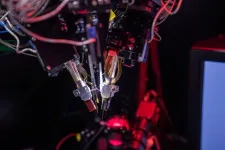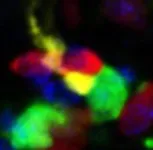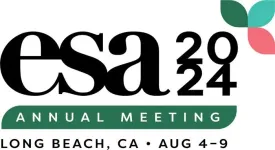(Press-News.org) Investigators at the UCLA Health Jonsson Comprehensive Cancer Center have uncovered new details about the role of a protein called interferon regulatory factor (IRF1) in cancer progression and treatment response, offering new insight that can potentially help improve the effectiveness of cancer immunotherapy.
The study, published in Cell Reports, reveals how IRF1 can both hinder and help the body's immune response to tumors, depending upon which cells the protein is found in.
“We know IRF1 plays a pivotal role in modulating antiviral immunity,” said Dr. Philip Scumpia, associate professor of medicine at the David Geffen School of Medicine at UCLA and senior author of the study. “But there were conflicting reports about whether IRF1 promotes or suppresses antitumor immunity. What was surprising to us was that the role of IRF1 was different depending upon which cells expressed it, potentially explaining the conflicting reports. Our findings add a layer of complexity to our understanding of IRF1 and its role in immunotherapy.”
Immunotherapy continues to be a powerful approach in cancer treatment. It works by harnessing the body’s immune system to recognize and attack cancer cells. While immunotherapy has shown success in treating certain types of cancer and can lead to long-term remission in some patients, it still does not work for everyone.
Understanding the mechanisms of proteins like IRF1 can help refine immunotherapy strategies, making them more effective for a broader range of patients, noted Scumpia.
To dissect the role of IRF1 in tumor growth and immune response, the team of researchers looked at what happens when IRF1 is missing in both tumor cells and surrounding cells.
“We previously showed that cells exposed to ionizing radiation, a well-known treatment for cancer, induced an immune response through IRF1. We wanted to see whether IRF1 regulated similar immune responses in growing tumors,” said Dr. Prabhat Purbey, a project scientist in the Scumpia laboratory and first author of the study.
First, the team created IRF1-deficient clones of various tumor cells and compared the growth of these genetically modified tumors to normal tumors, assessing immune cell infiltration using histology and flow cytometry. Then they examined the effect of immune checkpoint blockade therapy, a type of immunotherapy, on these tumors and performed single-cell RNA sequencing to understand the immune cell activation states.
They found that the presence of IRF1 in tumor cells can actually weaken the immune response by promoting T cell exhaustion and by affecting toll-like receptor and type-I interferon responses. This happens because IRF1 in tumor cells increases levels of several immune checkpoints, including IDO-1 and PD-L1, proteins that inhibit T cell activity while altering the expression of proteins involved in antigen presentation.
However, IRF1 is crucial for immune cell development, recruitment, and function of cytotoxic T cells and natural killer cells, key immune cells that can directly attack the tumor.
“These findings suggest that reducing IRF1 in tumor cells, or activating it in immune cells, could enhance cancer treatment effectiveness by boosting the body’s natural antitumor immunity,” said Scumpia, who is also a member of the UCLA Health Jonsson Comprehensive Cancer Center. “We now have a clearer picture of where IRF1 can impact immunotherapy and how we can tune it to help in the fight against cancer.”
While more study is needed to understand if targeting IRF1 in tumor cells or immune cells will be beneficial after a tumor has grown in the body, this research has helped clarify why IRF1 was shown to be a hindrance or a help in different cancer scenarios.
“The potential to manipulate IRF1 in specific ways could change the way we approach cancer immunotherapy," Scumpia said. "Our goal is to translate these findings into treatments that offer real hope and improved outcomes for cancer patients."
The study’s other authors, all from UCLA, are Joowon Seo, Manash Paul, Keisuke Iwamoto, Allison Daly, An-Chieh Feng, Ameya Champhekar, Justin Langerman, Katie Campbell, Dörthe Schaue, William McBride, Steven Dubinett, Antoni Ribas and Stephen Smale.
This work was supported in part by grants from the UCLA Health Jonsson Comprehensive Cancer Center, National Institutes of Health, the VA Office of Research and Development and the Howard Hughes Medical Institute.
END
Study reveals dual role of protein in cancer treatment
The protein IRF1 acts both as an enemy and an ally in the battle against cancer
2024-07-16
ELSE PRESS RELEASES FROM THIS DATE:
Friends and at-risk youth may need extra support for their mental well-being
2024-07-16
Friends of young people who self-harm or have suicidal thoughts may need additional support to prevent negative outcomes on their own mental wellbeing, in addition to the support needed by young people who self-harm.
While much research rightly focuses on young people at risk and their families, friendships are rarely considered in research into self-harm, according to a new study from experts at the University of Birmingham.
In an extensive literature review, the team set out to draw together all the research in this area to reach a better understanding of common themes around friendship and self-harm ...
Children living in deprived areas are three times more likely to need dental extractions in hospital
2024-07-16
Researchers at Queen Mary University of London have found that children living in areas with high levels of deprivation are three times more likely to have severe tooth decay that requires a dental extraction in hospital, compared with children living in more affluent areas. The findings highlight an urgent need for equitable access to preventive dentistry.
In the study, published today (16 July 2024) in BMJ Public Health, researchers analysed de-identified GP and hospital records for 600,000 children ...
Lowering systolic blood pressure below 120 mmHg may reduce dementia risk among Black, Latino populations
2024-07-16
FOR IMMEDIATE RELEASE
Monday, July 15, 2024
Contact:
Jillian McKoy, jpmckoy@bu.edu
Michael Saunders, msaunder@bu.edu
##
Lowering Systolic Blood Pressure below 120 mmHg May Reduce Dementia Risk Among Black, Latino Populations
A new study suggests that reducing systolic blood pressure below the clinically safe threshold of 120 mmHg over time may produce slight health-protective benefits against late-life dementia and help reduce racial and ethnic disparities in both hypertension and hypertension control.
Hypertension is one of the most modifiable risk factors for dementia, but most research on dementia risk reduction through blood ...
When to let Amazon sell for you
2024-07-16
AUSTIN, Texas — On Prime Day, Amazon shoppers will be able to browse over 600 million products. They may not be aware that most of those listings are from non-Amazon sellers, who account for 60% of sales on the platform. Most are small- and medium-sized businesses: bookstores selling used hardbacks, toymakers selling original goods, and distributors unloading clothes.
What shoppers also don’t see is the choice that the platform and the seller make about how to interact. Is it better ...
New OpenScope projects aim to pioneer the future of neuroscience
2024-07-16
By Jake Siegel
SEATTLE, WASH.—July 15, 2024—How do neurons react to magic mushrooms? What happens in the brain when we see motion, or when we recognize grain patterns in a piece of wood? How do our brains track the subtle changes in our friends’ appearances over time?
The Allen Institute has launched four projects to investigate these questions through OpenScope, a shared neuroscience observatory. Just as astronomers use a few well-equipped observatories to study the universe, the OpenScope program lets neuroscientists worldwide propose and direct experiments on the Allen Brain Observatory pipeline. ...
Silicon photonics light the way toward large-scale applications in quantum information
2024-07-15
In a significant leap forward for quantum technology, researchers have achieved a milestone in harnessing the frequency dimension within integrated photonics. This breakthrough not only promises advancements in quantum computing but also lays the groundwork for ultra-secure communications networks.
Integrated photonics, the manipulation of light within tiny circuits on silicon chips, has long held promise for quantum applications due to its scalability and compatibility with existing telecommunications infrastructure.
In a study published in Advanced Photonics, researchers from the Centre for Nanosciences and Nanotechnology (C2N), Télécom Paris, ...
Better together: spatial arrangement of three immune cells is key to attacking tumors
2024-07-15
There’s a frustrating fact about today’s immunotherapies for cancer. While sometimes they work beautifully — completely eliminating or greatly reducing cancer in particular patients — other times they don’t work at all. It’s a mystery.
Scientists have posed several hypotheses to explain the disparity. Perhaps it’s the number of mutations present in a tumor, with more mutations leading to better responses. Or maybe it’s the tissue environment surrounding the tumor, with some environments supporting and others suppressing effective immune responses. But so far, none of these ...
How a ‘social good’ firm is defined can impact its value creation and value capital
2024-07-15
Ventures that pursue both commercial and social value creation have grown in popularity in recent years, but a new study published in the Strategic Entrepreneurship Journal better defines four distinct types of social ventures. By training a business model lens on these social good ventures, the study offers insight on how the model choices impact a firm's value creation and value capture potential.
“Despite the popularity of the term ‘social entrepreneurship,’ not much was known about the business model of such companies yet,” says study co-author Lien De Cuyper of ...
American diets got briefly healthier, more diverse during COVID-19 pandemic
2024-07-15
UNIVERSITY PARK, Pa. — American diets may have gotten healthier and more diverse in the months following the start of the COVID-19 pandemic, according to a new study led by Penn State researchers.
The study — published in PLOS ONE — found that as states responded to the pandemic with school closures and other lockdown measures, citizens’ diet quality improved by up to 8.5% and food diversity improved by up to 2.6%.
Co-author Edward Jaenicke, professor of agricultural economics in the College ...
Media Tip Sheet: Symposia at ESA2024
2024-07-15
The latest ecological research will be on full display at the Ecological Society of America’s upcoming Annual Meeting in Long Beach, California, Aug. 4–9. A focal point of the conference, symposia consist of four 20-minute talks organized around a central theme of broad interest. These sessions consider topics from different angles, integrate multiple lines of evidence and offer new insights on ecological phenomena.
This year, Annual Meeting symposia will address nonmaterial (“cultural”) ecosystem services, nature-based solutions to problems like stormwater runoff and urban heat, ...
LAST 30 PRESS RELEASES:
Understanding sex-based differences and the role of bone morphogenetic protein signaling in Alzheimer’s disease
Breakthrough in thin-film electrolytes pushes solid oxide fuel cells forward
Clues from the past reveal the West Antarctic Ice Sheet’s vulnerability to warming
Collaborative study uncovers unknown causes of blindness
Inflammatory immune cells predict survival, relapse in multiple myeloma
New test shows which antibiotics actually work
Most Alzheimer’s cases linked to variants in a single gene
Finding the genome's blind spot
The secret room a giant virus creates inside its host amoeba
World’s vast plant knowledge not being fully exploited to tackle biodiversity and climate challenges, warn researchers
New study explains the link between long-term diabetes and vascular damage
Ocean temperatures reached another record high in 2025
Dynamically reconfigurable topological routing in nonlinear photonic systems
Crystallographic engineering enables fast low‑temperature ion transport of TiNb2O7 for cold‑region lithium‑ion batteries
Ultrafast sulfur redox dynamics enabled by a PPy@N‑TiO2 Z‑scheme heterojunction photoelectrode for photo‑assisted lithium–sulfur batteries
Optimized biochar use could cut China’s cropland nitrous oxide emissions by up to half
Neural progesterone receptors link ovulation and sexual receptivity in medaka
A new Japanese study investigates how tariff policies influence long-run economic growth
Mental trauma succeeds 1 in 7 dog related injuries, claims data suggest
Breastfeeding may lower mums’ later life depression/anxiety risks for up to 10 years after pregnancy
Study finds more than a quarter of adults worldwide could benefit from GLP-1 medications for weight loss
Hobbies don’t just improve personal lives, they can boost workplace creativity too
Study shows federal safety metric inappropriately penalizes hospitals for lifesaving stroke procedures
Improving sleep isn’t enough: researchers highlight daytime function as key to assessing insomnia treatments
Rice Brain Institute awards first seed grants to jump-start collaborative brain health research
Personalizing cancer treatments significantly improve outcome success
UW researchers analyzed which anthologized writers and books get checked out the most from Seattle Public Library
Study finds food waste compost less effective than potting mix alone
UCLA receives $7.3 million for wide-ranging cannabis research
Why this little-known birth control option deserves more attention
[Press-News.org] Study reveals dual role of protein in cancer treatmentThe protein IRF1 acts both as an enemy and an ally in the battle against cancer


